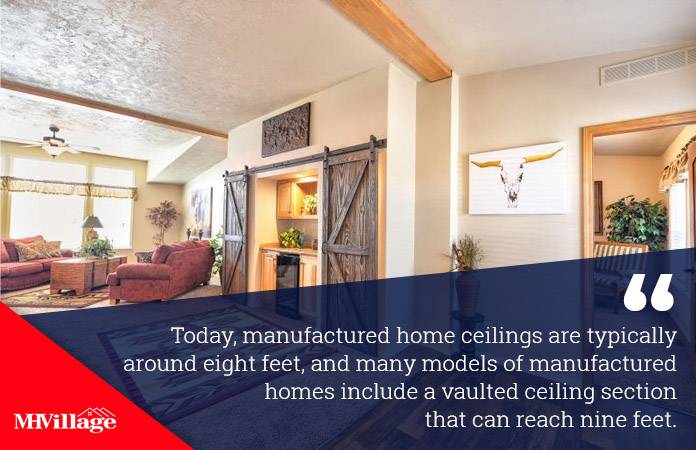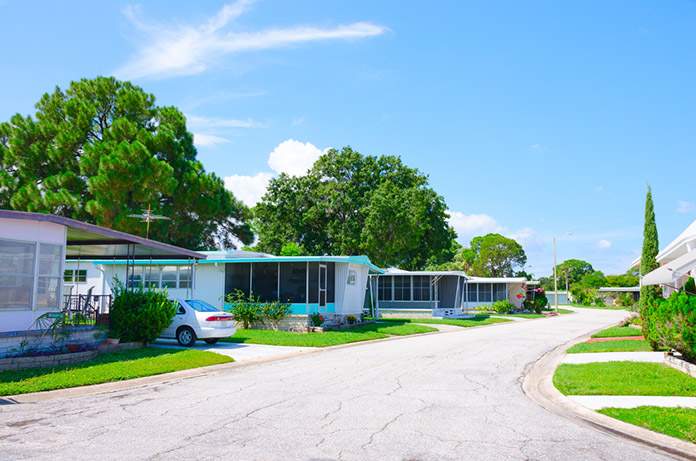It can be difficult to get an idea of how big a manufactured home is without seeing the home in person or having a visual reference. But the size of a manufactured home is critical information, as it affects how the home is moved and how it fits onto its lot. There are also a wide variety of mobile home sizes and floor plans on the market, meaning that the differences between one manufactured home and another can be substantial.
While it remains true that the best way to understand the size of a manufactured home is to see it with your own eyes, it can be important to conceptualize the position and layout of a mobile home before you can physically see it.
In this article, we’ll give the average manufactured home buyer some graphic tools that can help clarify mobile home sizes.
The Average Sizes and Dimensions of Mobile Homes
So, what is the average size of a mobile home? For a hypothetical “typical” single-wide manufactured home, the dimensions are as follows:
- 13 feet, 6 inches in height or less
- 76 feet long
- 16 feet wide
A visual representation of these dimensions looks something like this:

On a basic level, the dimensions of a mobile home are limited by what can be safely transported on roads and highways. Thus, manufactured homes are generally not built above 13’6” due to bridge clearances, and double- and triple-wide manufactured homes must be transported in sections and assembled at the home site.
However, there can be considerable variance in the dimensions of a mobile home. As we’ll see shortly, manufactured and mobile homes can be modified in many different ways that allow them to meet the housing needs of different types of homeowners.
Manufactured Home Size Comparison by Type
One of the major choices for manufactured home buyers is choosing between a single-wide, double-wide, or triple-wide model. These three size categories create homes that are radically different in size.
How different? Take a look at these charts to see just how much of a size difference exists between single-wide, double-wide and triple-wide manufactured home units:

What general dimensions can buyers expect from each different size of manufactured home?
Here’s a guide to the basics:
Single Wide Dimensions
Single wides are the smallest types of manufactured homes. Single-wide homes are almost always a rectangular shape and are usually two or three-bedroom homes with one or two bathrooms. Homeowners often add a porch to create additional living space, square footage, and curb appeal.
- Width: 12 to 18 feet
- Length: 40 to 80 feet
- Square Footage: 480 to 1,440 square feet
When it comes to single wide sizes, one of the most popular ratios among home buyers are 16 x 80 mobile homes.
Double Wide Dimensions
Double wides are the most popular type of manufactured home, as they provide substantially more space than single wides while remaining affordable. Double wides are moved in sections and attached together at the home site, and they offer many floor plan options that single wides can’t, including the open mobile home floor plans popular with many of today’s buyers.
- Width: 20 to 36 feet
- Length: 32 to 80 feet
- Square Footage: 640 to 2,560 square feet
Triple Wide Dimensions
Triple wide mobile homes are shipped in three sections and have the greatest variety of options for home configurations, including many options that give the appearance of a site-built home. Triple-wides offer the greatest amount of space and are great for large families, folks with lots of pets, or anyone who simply likes to live big.
- Width: 30 to 54 feet
- Length: 32 to 80 feet
- Square Footage: 960 to 3,600+ square feet
And for even larger homes, quadruple wide mobile homes offer many similar benefits of triple wides, just on a greater scale.
Many manufactured home builders also offer additions such as garages and carports that can be attached to manufactured homes. These can add considerable square footage, as well as potentially increasing the value of your manufactured home.
Mobile Home Ceiling Heights
Ceiling height can also be a major factor in making a house feel like a home. High ceilings tend to feel more roomy and comfortable and are considered a desirable feature in almost any kind of home–site-built or factory-built.
The original mobile homes, including models built before the introduction of the HUD Manufactured Housing Code in 1976, often had ceilings as low as seven feet. Today, manufactured home ceilings are much higher, typically around eight feet, and many models of manufactured homes include a vaulted ceiling section that can reach nine feet.

However, the height of any manufactured home is limited by what can be safely transported on a highway, so you won’t find many manufactured homes with ceilings above nine feet, apart from modular homes. A manufactured home’s maximum transportable height—i.e., the distance from the ground to the home’s highest point, including the height of its attic and roof—can be no higher than 13 feet, 6 inches. Thus, in most cases, nine feet is the limit of how high a manufactured home ceiling can be.
Mobile Home Floor Plans
The size of a manufactured home is only one factor affecting its livability. The floor plan of a manufactured home is also tremendously important to creating a space that meets each homeowner’s needs. The number of bedrooms and bathrooms, kitchen size, and the layout and flow of the home’s interior are all common points that manufactured home buyers look for.
Although most manufactured home builders don’t offer fully custom floor plans, there are a wide variety of mobile home floor plan options now available from popular home manufacturers. Today’s floor plan options often include the open, spacious floor plans that are currently popular with many home buyers, and they also offer far more bedroom and bathroom space than would be available in a comparably priced site-built home.
Many manufactured home dealers offer walk-through models, which are usually the preferred option for evaluating a floor plan. But it can also be useful to look at a floor plan and imagine yourself and your family living in a mobile home with those dimensions. The following sample mobile home floor plans will give manufactured home buyers an idea of what to expect from the floor plans of single wide, double wide, and triple wide manufactured homes.

Mobile Home Lot Sizes
For those purchasing a new manufactured home to be delivered to a home site, it’s important to ensure that your lot can accommodate the home you buy. Manufactured homes need a great deal of flat, clear space on each side of its intended site so that delivery personnel has enough room to maneuver the home into position.
Mobile home lot sizes vary greatly. Small lots may be 20′ x 60′ and would typically accommodate smaller single-wide homes. Larger lots may run 60′ x 120′ or even larger and would accommodate any size home. Buyers should be sure that their home will fit on their lot and that the lot gives enough room to maneuver.

Lots in manufactured home communities are created to offer sufficient space for a home to be transported and installed, although there will likely be restrictions on the size of the home. On the other hand, buyers placing manufactured homes on private land may need to do extensive manufactured home site preparation–like grading and clearing–before the lot is ready to receive a home. In either case, it’s also important for buyers to check local zoning restrictions and ensure that they understand any restrictions imposed on lot and/or home size.
Make sure that your lot also includes sufficient space for any features you plan to add, including:
- Driveway
- Garage or carport
- Gardens
- Children’s play areas
- Pet enclosures
By determining in advance which features their lot will need room to add and which manufacturer’s requirements will need to be met, a buyer can find a manufactured home site that more closely suits their individual needs.
Manufactured Home Size and Pricing
Finally, the bottom line: How much does the size of a manufactured home influence its price?

As you might expect, more square footage means a higher price, although the correlation isn’t always perfect. Double wide and triple wide manufactured homes almost always come at a higher price point than single wide homes but many factors such as amenities and features can figure prominently into the price of a manufactured or mobile home.
For example, let’s take a look at some cost numbers around the average manufactured home. When planning a purchase, it’s important to remember that this average price can be considerably higher if the buyer chooses to add on valuable amenities and extras, such as:
- Garage or Carport: $3,900 – $30,000
- Upgraded appliances: $1,200 – $5,600
- Upgraded countertops: $1,600 – $14,000
- Upgraded cabinets: $3,000 – $24,000
- Foundation/Basement: $3,000 – $39,500
- Upgraded insulation: $800 – $4,900
Manufactured home prices also tend to vary by region. Manufactured homes in the South (such as manufactured homes in Florida) tend to be slightly less expensive than manufactured homes in the West (such as manufactured homes in Arizona). And for permanently affixed manufactured homes, you’ll deal with all of the usual factors of a normal real estate market, such as surrounding property values.


